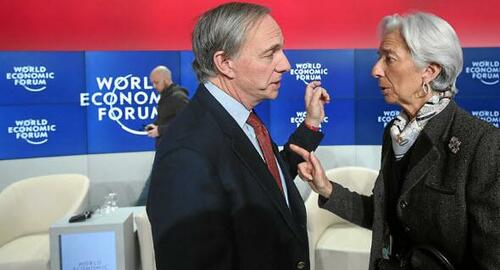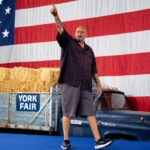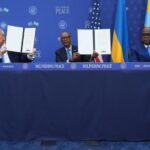
Authored by Peter Reagan via Birch Gold Group,
Ray Dalio looks at 500 years of economic history to make the case for gold...
“Stop talking about gold, Ray,” Christine Lagarde demanded just before the ‘Ending the Experiment’ session at the Annual Meeting of the World Economic Forum in Davos, January 22, 2015.
Image CC BY-NC-SA 2.0 courtesy of World Economic Forum
In his latest book, Bridgewater Associates founder Ray Dalio looked at 500 years of economic history to give investors an idea of the cycle we now find ourselves in. The last such cycle, says Dalio, occurred between 1930-1945 and caused a shift in global influence, as it is doing now.
In order to make sense of the following, you have to understand the premise of Dalio’s book Principles for Dealing with the Changing World Order (Why Nations Succeed and Fail). Here’s that book, in a nutshell:
The times ahead will likely be radically different from those we’ve experienced in our lifetimes—but similar to those that have happened many times before. Studying history lets us find recurring patterns that determine likely future developments.
In other words, history repeats itself in ways the knowledgeable can recognize.
Dalio makes an extremely compelling case in his book, which is a must-read. For those of us who don’t have the time to digest all data-packed 576 pages, Dalio recently gave a sort of back-of-the-envelope sketch to The Economic Times.
“We have five different kinds of wars happening now – a trade war, a technology war, a geopolitical influence war, a capital war and a military war. That kind of confluence produces these difficult periods, the last one was 1930 to 1945 and that is what we are in the midst of. ”
Where are we today?
All of the hallmarks of the end of a global reserve currency regime are here.
They are as follows:
#1: Governments run out of money
First, when governments run out of money, they need more money than they can get. They create a lot of debt and they print a lot of money.
Sound familiar?
“We have had the largest debt increases and money creations particularly in the leading world reserve currency, the dollar, although that has been true in the case of euro and it has been true in the yen too and that has a big effect,” Dalio said.
By itself, this doesn’t spell the end of a global reserve currency…
#2: Conflict between left-wing and right-wing populists
Dalio offers us a handy definition of “populism:”
Populism consists of people who are representatives who will fight for their way of doing things, rather than compromise.
He goes on to describe the current U.S. political situation as, “almost a civil war.”
He points out that open conflict in the U.S. could be as near as “an election in which neither side accepts losing.”
Obviously, an internal conflict would be incredibly disruptive far beyond our nation’s borders.
But that’s not all…
#3: The rise of new economic superpowers
Back when our current monetary system was designed, in 1945, the U.S. was the wealthiest nation on earth. We owned 80% of the world’s gold reserves (back when gold was money), and half the entire world’s economic and military strength.
Dalio believes that the U.S. is experiencing a “relative” decline on the global stage, with countries like China waiting in the wings to steal the spotlight.
As Dalio points out, these power struggles have historically been solved through conflict of one kind or another – and he believes the U.S. is facing 5 different wars right now: a trade war, a technology war, a geopolitical war, a capital war and a military war. (We’ll gloss over the details of all these battles.)
Dalio sees a stagflationary period as a given, considering both historical precedent and our present reality. For the ordinary investor, certainly one dealing in U.S. dollars, Dalio says that the options are few and far between. During periods of stagflation, physical gold and other commodities break out while most other asset classes (especially risk-on investments) underperform. Much of Dalio’s practical advice in his book reiterates the importance of savings diversification, with the renowned investor emphasizing that a lack of correlation between assets should be paramount.
To be fair, Dalio has long recommended diversification with gold. For example, in 2019 he told the International Business Times:
I believe that it would be both risk-reducing and return-enhancing to consider adding gold to one’s portfolio.
If we’d followed Dalio’s advice and bought told on 17 July 2019, we’d be up 30% on that investment today. The man’s the founder of the world’s largest and arguably most successful hedge fund. Maybe his words are worth heeding.
* * *
With global tensions spiking, thousands of Americans are moving their IRA or 401(k) into an IRA backed by physical gold. Now, thanks to a little-known IRS Tax Law, you can too. Learn how with a free info kit on gold from Birch Gold Group. It reveals how physical precious metals can protect your savings, and how to open a Gold IRA. Click here to get your free Info Kit on Gold.
Authored by Peter Reagan via Birch Gold Group,
Ray Dalio looks at 500 years of economic history to make the case for gold…
“Stop talking about gold, Ray,” Christine Lagarde demanded just before the ‘Ending the Experiment’ session at the Annual Meeting of the World Economic Forum in Davos, January 22, 2015.
Image CC BY-NC-SA 2.0 courtesy of World Economic Forum
In his latest book, Bridgewater Associates founder Ray Dalio looked at 500 years of economic history to give investors an idea of the cycle we now find ourselves in. The last such cycle, says Dalio, occurred between 1930-1945 and caused a shift in global influence, as it is doing now.
In order to make sense of the following, you have to understand the premise of Dalio’s book Principles for Dealing with the Changing World Order (Why Nations Succeed and Fail). Here’s that book, in a nutshell:
The times ahead will likely be radically different from those we’ve experienced in our lifetimes—but similar to those that have happened many times before. Studying history lets us find recurring patterns that determine likely future developments.
In other words, history repeats itself in ways the knowledgeable can recognize.
Dalio makes an extremely compelling case in his book, which is a must-read. For those of us who don’t have the time to digest all data-packed 576 pages, Dalio recently gave a sort of back-of-the-envelope sketch to The Economic Times.
“We have five different kinds of wars happening now – a trade war, a technology war, a geopolitical influence war, a capital war and a military war. That kind of confluence produces these difficult periods, the last one was 1930 to 1945 and that is what we are in the midst of. ”
Where are we today?
All of the hallmarks of the end of a global reserve currency regime are here.
They are as follows:
#1: Governments run out of money
First, when governments run out of money, they need more money than they can get. They create a lot of debt and they print a lot of money.
Sound familiar?
“We have had the largest debt increases and money creations particularly in the leading world reserve currency, the dollar, although that has been true in the case of euro and it has been true in the yen too and that has a big effect,” Dalio said.
By itself, this doesn’t spell the end of a global reserve currency…
#2: Conflict between left-wing and right-wing populists
Dalio offers us a handy definition of “populism:”
Populism consists of people who are representatives who will fight for their way of doing things, rather than compromise.
He goes on to describe the current U.S. political situation as, “almost a civil war.”
He points out that open conflict in the U.S. could be as near as “an election in which neither side accepts losing.”
Obviously, an internal conflict would be incredibly disruptive far beyond our nation’s borders.
But that’s not all…
#3: The rise of new economic superpowers
Back when our current monetary system was designed, in 1945, the U.S. was the wealthiest nation on earth. We owned 80% of the world’s gold reserves (back when gold was money), and half the entire world’s economic and military strength.
Dalio believes that the U.S. is experiencing a “relative” decline on the global stage, with countries like China waiting in the wings to steal the spotlight.
As Dalio points out, these power struggles have historically been solved through conflict of one kind or another – and he believes the U.S. is facing 5 different wars right now: a trade war, a technology war, a geopolitical war, a capital war and a military war. (We’ll gloss over the details of all these battles.)
Dalio sees a stagflationary period as a given, considering both historical precedent and our present reality. For the ordinary investor, certainly one dealing in U.S. dollars, Dalio says that the options are few and far between. During periods of stagflation, physical gold and other commodities break out while most other asset classes (especially risk-on investments) underperform. Much of Dalio’s practical advice in his book reiterates the importance of savings diversification, with the renowned investor emphasizing that a lack of correlation between assets should be paramount.
To be fair, Dalio has long recommended diversification with gold. For example, in 2019 he told the International Business Times:
I believe that it would be both risk-reducing and return-enhancing to consider adding gold to one’s portfolio.
If we’d followed Dalio’s advice and bought told on 17 July 2019, we’d be up 30% on that investment today. The man’s the founder of the world’s largest and arguably most successful hedge fund. Maybe his words are worth heeding.
* * *
With global tensions spiking, thousands of Americans are moving their IRA or 401(k) into an IRA backed by physical gold. Now, thanks to a little-known IRS Tax Law, you can too. Learn how with a free info kit on gold from Birch Gold Group. It reveals how physical precious metals can protect your savings, and how to open a Gold IRA. Click here to get your free Info Kit on Gold.





